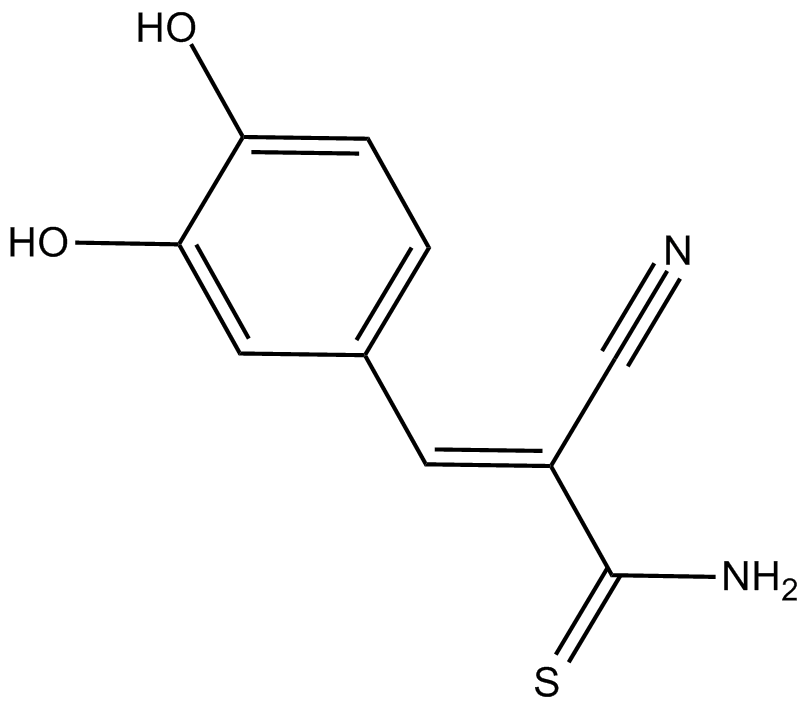AG-213 (Synonyms: Tyrphostin AG-213,Tyrphostin 47) |
| カタログ番号GC11024 |
表皮成長因子(EGF)受容体キナーゼの阻害剤
Products are for research use only. Not for human use. We do not sell to patients.

Cas No.: 122520-86-9
Sample solution is provided at 25 µL, 10mM.
AG-213 is an inhibitor of protein tyrosine kinases (PTKs) and epidermal growth factor (EGF) receptor kinase [1,2].
Protein tyrosine kinases (PTKs) have been involved in regulating cell proliferation, cell differentiation, and signaling processes in the immune system. Dysfunction of protein tyrosine kinases result in inflammatory responses and diseases including cancer, atherosclerosis, and psoriasis [3]. The epidermal growth factor receptor (EGFR) is a transmembrane glycoprotein. Activation of EGFR results in autophosphorylation of receptor tyrosine kinase and has been involved in regulating cellular proliferation, differentiation, and survival. Overexpression of EGFR has been identified in a variety of tumor cell lines and has been associated with poor prognosis and decreased survival [4].
Administration of AG 213(100 μM) interfered with HUVEC focal adhesion and stress fiber formation. Pretreatment of monolayers with AG 213 (25, 50, and 75 μM) produced partial and incremental inhibition of HUVEC migration. In HUVEC, treatment with tyrphostin AG 213 (25 and 50 μM) demonstrated partial inhibition of stress fiber assembly compared with cells treated with 100 μM AG 213 [1]. AG 213 inhibited adhesion-associated tyrosine phosphorylation of pp125FAK activity in HUVEC [1]. AG-213 inhibited the activity of epidermal growth factor (EGF) receptor kinase with an IC50 value of 2.4 μM in the human epidermoid carcinoma cell line A431 [2].
References:
[1] Romer L H, McLean N, Turner C E, et al. Tyrosine kinase activity, cytoskeletal organization, and motility in human vascular endothelial cells[J]. Molecular Biology of the Cell, 1994, 5(3): 349-361.
[2] Gazit A, Yaish P, Gilon C, et al. Tyrphostins I: synthesis and biological activity of protein tyrosine kinase inhibitors[J]. Journal of medicinal chemistry, 1989, 32(10): 2344-2352.
[3] Levitzki A, Gazit A. Tyrosine kinase inhibition: an approach to drug development[J]. Science, 1995, 267(5205): 1782.
[4] Herbst R S. Review of epidermal growth factor receptor biology[J]. International Journal of Radiation Oncology Biology Physics, 2004, 59(2): S21-S26.
| Cas No. | 122520-86-9 | SDF | |
| 同義語 | Tyrphostin AG-213,Tyrphostin 47 | ||
| Chemical Name | 2-cyano-3-(3,4-dihydroxyphenyl)-2E-propenethioamide | ||
| Canonical SMILES | N#C/C(=C\c1ccc(O)c(O)c1)/C(=S)N | ||
| Formula | C10H8N2O2S | M.Wt | 220.2 |
| 溶解度 | ≤10mg/ml in ethanol;20mg/ml in DMSO;15mg/ml in dimethyl formamide | Storage | Store at -20°C |
| General tips | Please select the appropriate solvent to prepare the stock solution according to the
solubility of the product in different solvents; once the solution is prepared, please store it in
separate packages to avoid product failure caused by repeated freezing and thawing.Storage method
and period of the stock solution: When stored at -80°C, please use it within 6 months; when stored
at -20°C, please use it within 1 month. To increase solubility, heat the tube to 37°C and then oscillate in an ultrasonic bath for some time. |
||
| Shipping Condition | Evaluation sample solution: shipped with blue ice. All other sizes available: with RT, or with Blue Ice upon request. | ||
| Prepare stock solution | |||

|
1 mg | 5 mg | 10 mg |
| 1 mM | 4.5413 mL | 22.7066 mL | 45.4133 mL |
| 5 mM | 0.9083 mL | 4.5413 mL | 9.0827 mL |
| 10 mM | 0.4541 mL | 2.2707 mL | 4.5413 mL |
Step 1: Enter information below (Recommended: An additional animal making an allowance for loss during the experiment)
 g
g
 μL
μL

Step 2: Enter the in vivo formulation (This is only the calculator, not formulation. Please contact us first if there is no in vivo formulation at the solubility Section.)
Calculation results:
Working concentration: mg/ml;
Method for preparing DMSO master liquid: mg drug pre-dissolved in μL DMSO ( Master liquid concentration mg/mL, Please contact us first if the concentration exceeds the DMSO solubility of the batch of drug. )
Method for preparing in vivo formulation: Take μL DMSO master liquid, next addμL PEG300, mix and clarify, next addμL Tween 80, mix and clarify, next add μL ddH2O, mix and clarify.
Method for preparing in vivo formulation: Take μL DMSO master liquid, next add μL Corn oil, mix and clarify.
Note: 1. Please make sure the liquid is clear before adding the next solvent.
2. Be sure to add the solvent(s) in order. You must ensure that the solution obtained, in the previous addition, is a clear solution before proceeding to add the next solvent. Physical methods such as vortex, ultrasound or hot water bath can be used to aid dissolving.
3. All of the above co-solvents are available for purchase on the GlpBio website.
Quality Control & SDS
- View current batch:
- Purity: >98.00%
- COA (Certificate Of Analysis)
- SDS (Safety Data Sheet)
- Datasheet
Average Rating: 5 (Based on Reviews and 20 reference(s) in Google Scholar.)
GLPBIO products are for RESEARCH USE ONLY. Please make sure your review or question is research based.
Required fields are marked with *



















